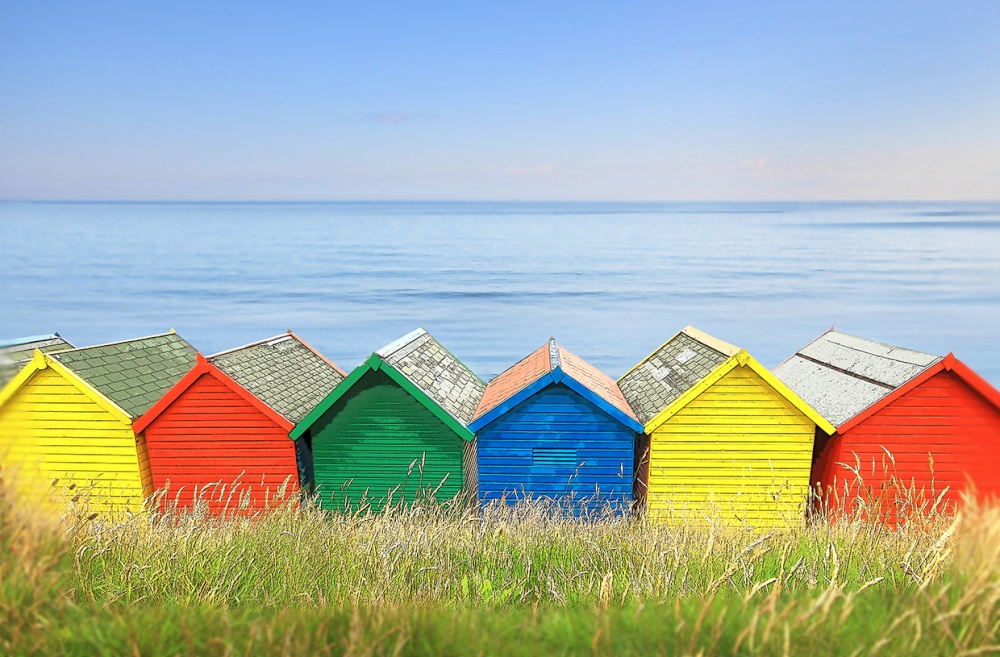
- Image by PicturesOfEngland.com member (view gallery)
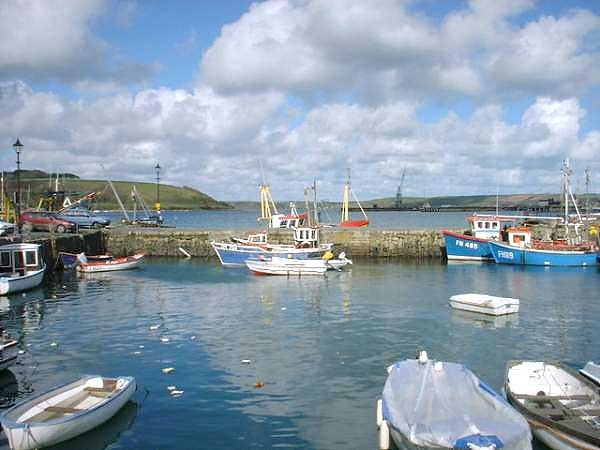
Falmouth Harbour, Falmouth, Cornwall - Image by PicturesOfEngland.com member Frances Wartnaby (view gallery)
Think of Falmouth and you immediately think of the sparkling sea in a bay alive with busy colourful pleasure and sailing boats all jostling along in bright sunshine. You think too, of wide promenades lined with Palm trees and beautiful gardens with sprawling lawns edged with an abundance of scented flowers. Flowers bloom early in Falmouth for this lovely holday resort is as well known for its mild climate as it is for it's beautiful bay which forms an excellent base for yatching and the beaches offer safe bathing.
Falmouth has seen maritime activity since the reign of Queen Elizabeth 1st. A packet service first began in the year 1698 but the towns fastest period of growth and development was centred upon the 60 years of the French wars. The packet commanders were at the heart of this period and it was to meet their demands that many grand houses where built. The year 1860 saw the demise of the packet service which left a huge gap in the local economy and it is this that led to the development of the dockyards. Falmouth was ideal for this, having the 3rd largest natural harbour in the world. It is believed it was Sir Walter Raleigh who first recommended Falmoth as a port after noting it's natural strategic advatages. To-day, shipping from all over the world uses the harbour. There is safe anchorage on the esturary of the Fal.
The first RNLI boat Robert Newborn was built in 1867 and the present RNLI boat was named Robert Cox Scott by the Queen on the 1st May, 2002. This RNLI boat is only one of four to be names by Royalty.
Henry VIII's Pendennis Castle , built in 1543 overlooks the harbour entrance and provides a good viewpoint. An east window on the 17th-century church of King Charles the Martyr dedicted to King Charles I, depicts the King holding the execution axe.
There are many attractive 18th and 19th-century buildings to be seen in the older part of the town. The Customs House and Grove Hill House are two very fine examples.
As you can see Falmouth is to be enjoyed for many reasons, maritime history, elegant buildings and beautiful beaches. Its excellent climate makes it an appealing holiday centre at any time of year, for there is always so much to be enjoyed. Explore the delightful beaches and coves, pop in to the local inns and be entertained by locals who all have a story ot two to tell of the romantic and adventurous days when the little bays along this coastline were used by smugglers. And there will be tales of the great and daring deeds of the RNLI. You will enjoy them all.
The coutryside around here is very beautiful and a stones throw away you can visit the Argal and College Water Park and a few miles further south is the famous Poldark Mine. There are many lovely and interesting gardens all with a wealth of rare and beautiful plants and flowers; Penjerrick, Trebah and Carwinion to name but a few. Falmouth has a good museum, so too, does the nearby town of Helston. If it's good walks that you are looking for then you should tread the South West Coast Path for this really does remind you that England is indeed a jewel set within a silver sea.
ID#46
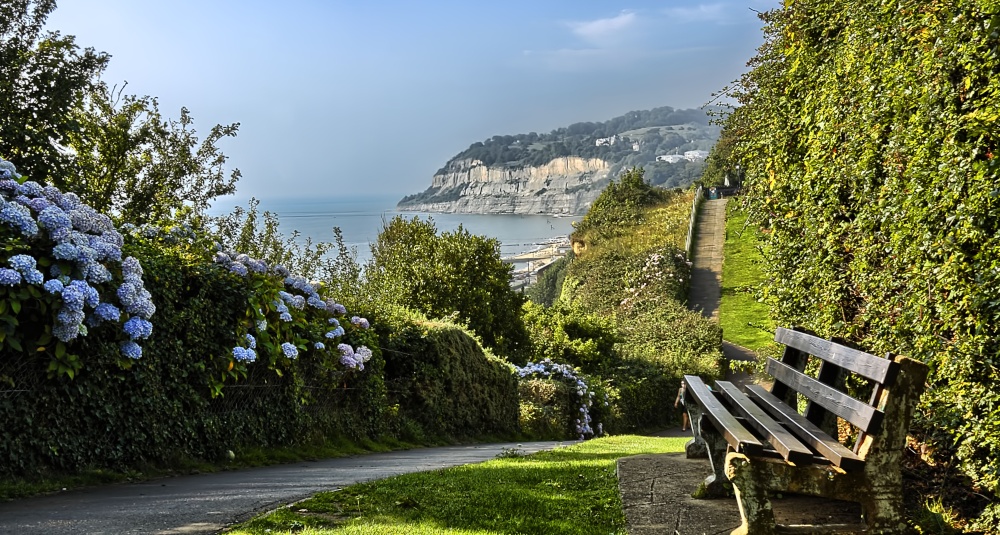
Cliff top path, Shanklin, Isle of Wight - Image by PicturesOfEngland.com member M3Wheels (view gallery)
This is a busy and popular seaside town with cliffs rising in places to a height of around 150ft, the lower slopes lead down to the beach which opens up to a delightful bay.
Shanklin has its historic places, the wooded Chine is a noted beauty spot where French raiders were defeated in an engagement of 1545. The poet Keats is known to have written in the shade of its tall trees and this is believed to have been amongst his favourite places, perhaps he was attracted by the sparkling little stream running through the deep gorge, as this is a perfectly peaceful place to idle away a few hours and is particularly pleasant on a balmy evening when woods and waterfall are illuminated against the night sky.
Visitors to Shanklin make a bee-line for the Old Village, this lies at the inland end of the Chine and is of picture-postcard charm with lovely old thatched cottages, quaint shops and olde-worlde tea-rooms serving an array of scrumptious seafood filled sandwiches and delectable cream teas. In the village several pubs offer excellent food, ales and wine and some have evening entertainment.
Shopping in Shanklin is mostly confined to its two main streets, here you will find a good mixture of shops offering the usual requisites for everyday living, and individual shops selling art and souvenirs. There are also plenty of pubs and cafes.
A ferry brings visitors over from the mainland to Ryde Pier, the journey to Shanklin continues by road or rail, so Sandown is an easy place to reach for a pleasant day out, weekend or a longer stay to enjoy a jolly family holiday and allow you the time to explore this lovely island retreat.
ID#33267
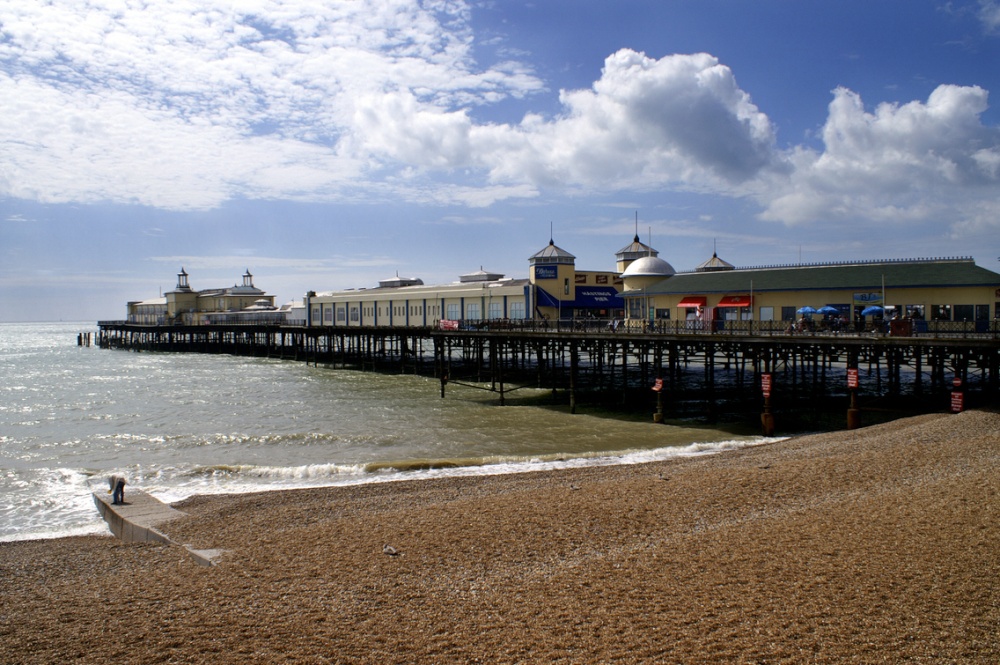
Hastings pier. - Image by PicturesOfEngland.com member Peter Evans (view gallery)
Hastings is an old fishing town along the southern coast of England. It offers all the traditional amusements of the seaside but retains much of the character of its colourful past.
Rich in history, Hastings is famous world wide for its famous battle in 1066 between the invading Normans and the defending Saxons, a battle which changed the course of British history - The Battle of Hastings. The actual battle itself took place 6 miles inland from the town of Hastings, at a smaller town aptly named 'Battle'. William the Conquerer stepped ashore at Norman's Bay, a beach to the west of Hastings, and the massive Conquerer's Stone, now near the pier, is supposed to be the dining table of where he ate his first meal in England.
There is also a ruined Norman castle on a hill at Hastings which was built a year after the famous Norman invasion. The main remains are parts of the North and East walls, a gatehouse, a tower and an arch, and the dungeons.
Old parts of the town of Hasting's have twisting narrow streets and timbered houses and it's along this part of Hastings you will find the Fishermen's Museum, which holds the last of the town's sailing luggers. You will find two fine churches in Hasting's - St Clement's, which dates from the late 14th century, and the Church of All Saints, which dates from the 15th century. Near the castle are St Clements Caves which is the most extensive cave system in south-east England, and once used by smugglers as secret routes and store chambers. You can go on a tour of these caves whcih gives you a great insight into life in those times. All in all Hastings offers the visitor a great holiday. With Caves, Castles, Amusements, a grand victorian pier, amazing history, and Country Parks with nature trails and clifftop walks, Hastings has become a major tourist resort.
ID#5
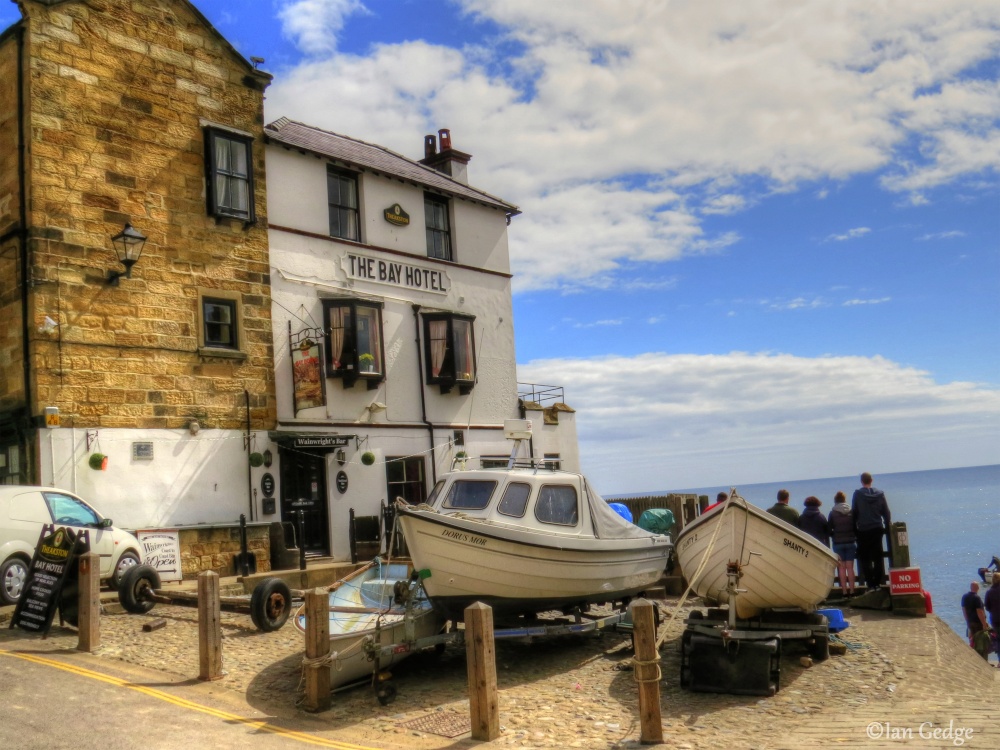
Robin Hood's Bay - Image by PicturesOfEngland.com member Ian Gedge (view gallery)
The talk in the local pub is all of Robin Hood, did he pass through this bay whilst journeying to Whitby, or did he not? the considered opinion seems to be that any connection between the outlaw and this beautiful bay is rather dubious. That being said, one does though, continue to ponder the possibility for this little place is alive with myths and legends of the smuggling trade that flourished here in the 18th-century.
The pretty village seemingly tumbles down the main cobbled street and finishes up where the sea laps the shore. Little cottages, mostly of stone with bright red roofs, some three storey's high, cling precariously to the cliffs upon which this village is built. It is a charming place and the little alleyways and terraces do indeed evoke images of smuggling. Legend has it that a tunnel through which King's Beck discharges into the sea was used by smugglers, and that other tunnel's branch from it in a network that runs beneath most of the village.
This is one of the richest stretches of coast for fossils in England, low tide exposes a sea bed full of tide and rock pools which offer wonderful examples such as the oyster-like Liostrea and coiled ammonites - known in these parts as St.Hilda's Serpents. The oldest rocks about here are said to date from the Jurasic Period.
A walk across the bay to nearby Ravenscar at low tide can be richly rewarding. The scenery all around is nothing less than spectacular, especially when the waves are tinged bright copper by a golden, setting sun. There is though, a continuing battle between land and sea and raging storms have claimed many buildings. Over the years, many cottages and great chunks of cliff have been lost to the sea and this has caused the building of a huge rock sea wall to protect the village.
The village offers quaint shops, cafes and excellent old inns and pubs. Beware though, the road down into the village thrusts deep and twists at sharp angles. Thoughtfully, handrails have been provided to help the visitor navigate the steeply stepped street. They are well used by locals and all who visit this beautiful bay. Oh, and by the way, if you are lucky, you just might catch a glimpse of Robin Hood on his way to Whitby!
Attractions in the area include the North Yorkshire Moors Railway, Wheeldale Roman Road and the Newtondale Forest Drive.
ID#361
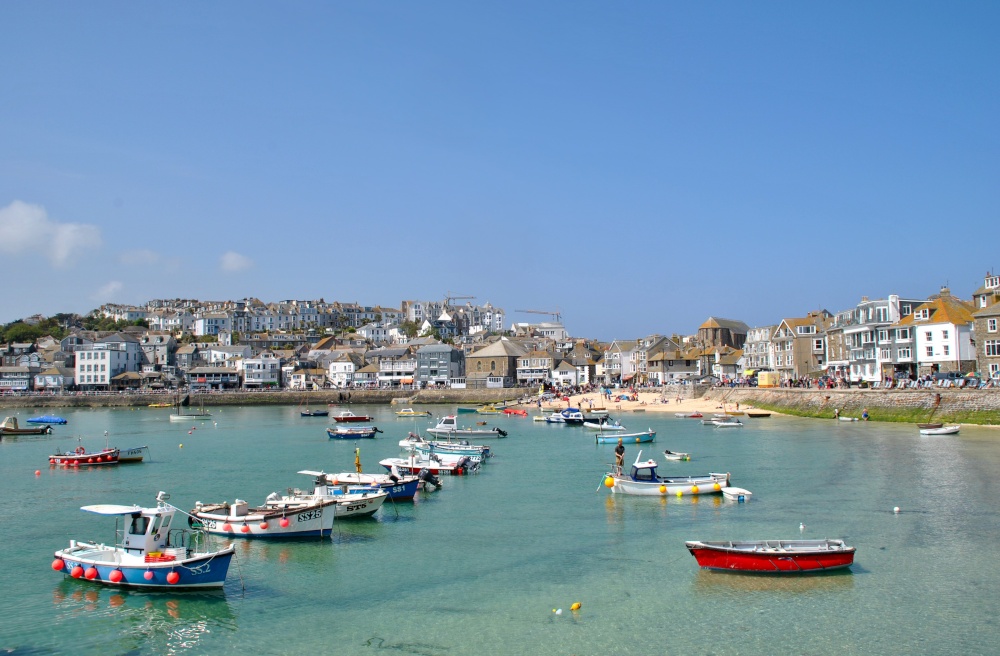
St Ives, Cornwall - Image by PicturesOfEngland.com member Kevin Tebbutt (view gallery)
There is a magical quality surrounding the whole of the Cornish coast of which St.Ives is a small but special part. The charm of this colourful former pilchard fishing village, where at one time it was not unusual to catch sight of fishermen surveying their catch of pilchards or salmon bass, on the beach, has been the inspiration for artists for over two centuries. As well as enchanting beach and seascapes, the beautiful old cottages, rising steeply up cobbled ways above the little town's ancient harbour, spring to life in from canvasses painted by noted artists, such as James McNeill Whistler and Walter Sickert who came to St.Ives in the 19th-century. Noted 20th-century sculptress, Dame Barbara Hepworth, spent most of her life in St. Ives. Her stunning work of Our Lady and Child is in the parish church of St.Ia, and outside the guildhall stands 'Dual Form', a sculpture she presented to the town in celebration and appreciation of the town's reputation as a paradise for artists. This splendid reputation remains today.
A glorious area of sheer enchantment is the old part of the town between the harbour and Porthmeor beach. Here, you will find a bewildering maze of narrow streets and lanes, crammed with a mix-match of picturesque old buildings. The area has much of visual delight for the observant visitor. Above Porthmeor sands lies the imaginative building that is home to Tate St.Ives. The gallery offers a wonderful opportunity to view paintings and works of modern art, the work of artists inspired by the area's abundance of tin, copper, semi-precious stones, rugged cliffs, sandy coves, ancient harbours and beautiful creeks.
Away from the beautiful sandy bays there are winding country lanes with hedgegrows that are laden with wild flowers, these little lanes lead to a hinterland of beautiful countryside, where you can come upon a tranquil villages with a smattering of old stone colour washed cottages or spot in the distance a lonely ruined engine-house, standing as a silent witness to Cornwall's former tin and copper mining industry.
All around St.Ives there are welcoming ancient inns and public houses offering a generous feast of tasty, freshly caught fish and seafood. Historic churches include St. Leonard's, a small church dating from the Middle Ages. It stands on the spot where St.Ia, after whom the town is named, is said to have landed in a coracle from Ireland during the 6th-century. St. Leonard's was the fishermen's church but it now serves other uses.
It is though and always will be the golden sandy beaches and magic of the mighty Atlantic that draws an endless stream of visitors to this lovely part of Cornwall. Porthmeor beach is ideal for surfing, while the sheltered beaches of Porthgwidden and Porthminster offer superb sun bathing and swimming opportunities for all the family. Fishing boats, gaily painted pleasure craft and yachts, all jostle for position along the lively harbour where you can often catch sight of lobster pots being hauled onto the quay.
There is much to see and do in this attractive and atmospheric resort. Garden enthusiasts will be delighted by the variety of sub-tropical flowers, whose growth is encouraged by the all year round mild climate - a factor that draws visitors in every season. For art lovers, the bright cobbled streets are crammed with craft shops, art galleries and antique centre's. Food lovers will enthuse over the choice of mouth watering dishes served in superb restaurants and little children, will enjoy hours spent building sand castles only to watch a wave knock them down again. The mighty Atlantic will thrill and enthral as you explore rocky cliff formations, carved by the ravages of turbulent seas. It is a refreshing place to be, the pace of life is slower, more gentle and the welcome is warm and sincere. For fun, sun, sand and sea served up with a good measure of artistic and historic flavour, a visit to St. Ives is a must.
ID#117
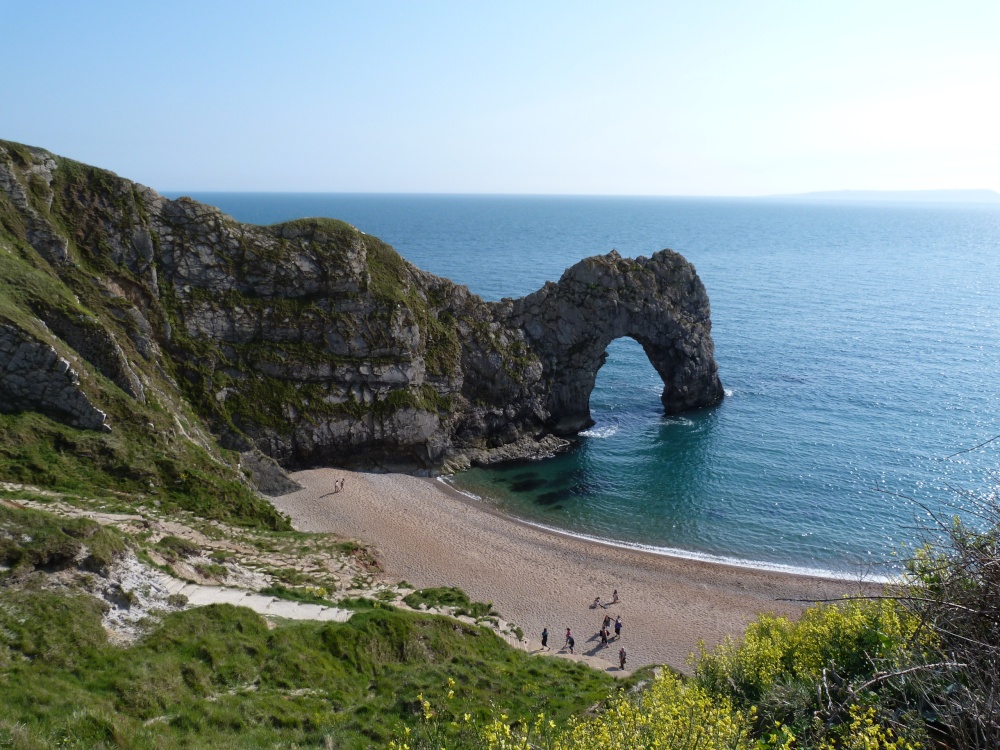
Durdle Door - Image by PicturesOfEngland.com member JudiJ (view gallery)
On a coast of fabulous high white cliffs there are few views to rival the spectacular Durdle Door. This natural phenomena, carved by the sea must rank as one of the most photographed scenes on the Jurassic Coast, it is certainly one of the coastal wonders of Britain.
It is a beautiful place, a shingle cove surrounded by rocks where a 'door' has been formed by the sea eating away at relatively soft rock, leaving an exquisite open arch of hard Portland stone. Crystal clear waters flow through the door, sweeping softly up the pretty sloping beach which is used for bathing and this, together with other little coves make it a pleasurable place for sub-aqua enthusiasts.
Lying a short distance from famed Lulworth Cove where fascinating arms of rock enfold pools of water left by a retreating tide, make this a picturesque and exciting place to explore. Lulworth has delightful thatched cottages, pleasant shops and friendly inns and quaint shops, and cafe's. At nearby Bat's Head, a smaller arch carved by waves can be seen - this is affectionately known as the 'mousehole' it is beneath massive rock formations jutting out into the sea. From the mossy headland above there are seascapes of incomparable splendour.
Places to visit include: Bowleaze Cove, Kimmeridge Bay, Swanage Railway, Corfe Castle (NT) and Wareham - pretty market town.
ID#26
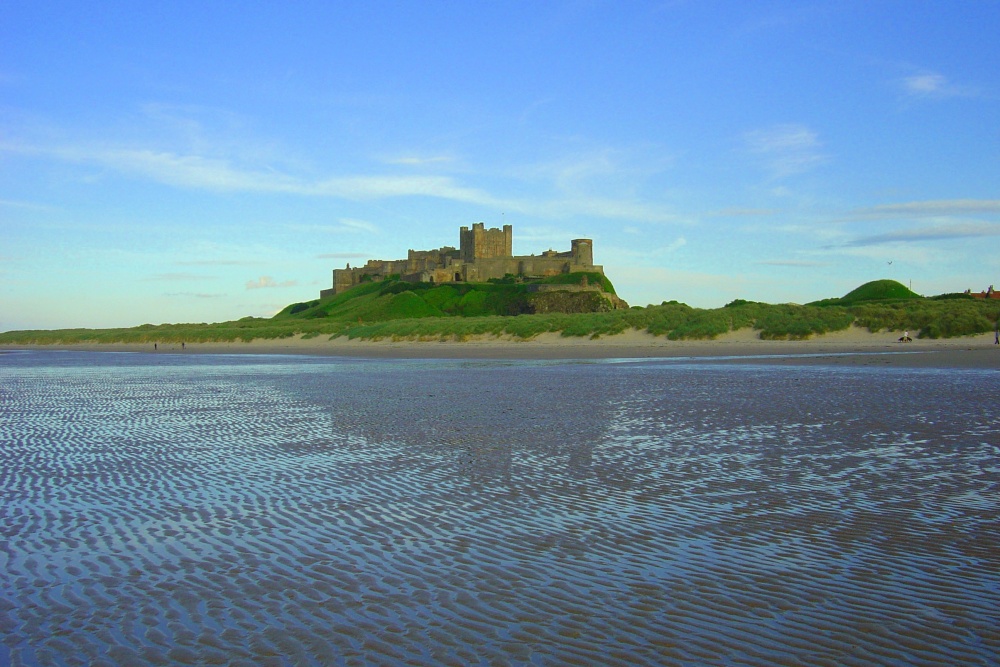
Bamburgh Castle from the Beach - Image by PicturesOfEngland.com member Jill Giles (view gallery)
Bamburgh's huge Norman castle was once the seat of the Kings of Northumbria. It is set on a Basalt outcrop overlooking the limitless beauty of the North Sea coastline with far reaching views of the Farne Islands and Holy Island.
The castle has a turbulent history, during the War of the Roses it was a Lancastrian stronghold, and it was to Bamburgh that Henry VI and his wife Queen Margaret of Anjou fled, following the Battle of Hexham when they were defeated by the Yorkists.
Bamburgh Castle is in private ownership, it is the home of the Armstrong family. The glittering castle we see today is due to the tireless work of the Ist Lord Armstrong, wealthy industrialist, who began the restoration of Bamburgh in 1890. The late Lord Armstrong continued with his ancestors inspirational work and saw his dream through to fruition. It is now one of the most beautiful and best preserved castles in England. The rich interior and magnificent collections on display are matched only by the castle's idyllic location.
All the rooms on view contain fine furniture, tapestries, paintings, exquisite porcelain and in the Armoury, you can see Arms and Armour dating from the 15th to the 19th century including pikes and muskets issued to the militia at the time of the Napoleonic Wars. Rooms open to public view include a series of reception rooms, the magnificent King's Hall, the Cross Hall, the Bakehouse, the Victorian Scullery and Dungeons. The Ist Lord Armstrong was an engineer, inventor and industrialist. His memory is honoured by a museum dedicated to his life and times which is sited in what was once the Laundry.
Bamburgh Castle is open from April to October, it is a place of historic charm and exceptional beauty which is well worth a visit.
ID#102
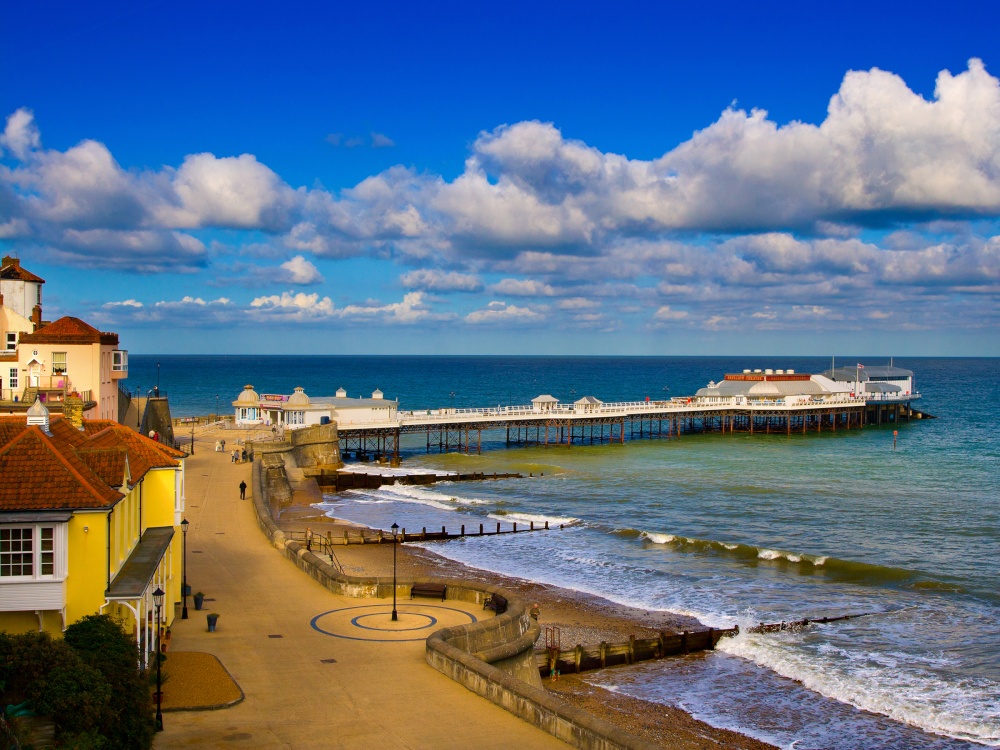
Cromer, Norfolk - Image by PicturesOfEngland.com member David Swann (view gallery)
Famous for delicious Crab for which folk still travel for miles to catch fresh, or buy from the quayside. To this day Cromer still displays an aura of Victorian and Edwardian charm that made it a popular tourist destination in the 18th and 19th-century. It remains very much a family resort with an appealing sandy beach, fine pier, pleasant gardens and colourful promenade. The history of the town is inextricably linked to fishing and the gallantry of its lifeboat crew is well documented in the Lifeboat Museum, housed in the old lifeboat house. Cromer Museum is housed in a row of enchanting fisher men's cottages, near to the church. As well as showing crabbing industry displays, Cromer Museum records much of local history.
Cromer parish church has a magnificent interior and at over 160ft, it's tower is the tallest in Norfolk. For those who enjoy viewing churches, this one is surely a must. Royal Cromer Golf Club in it's fabulous setting overlooking the sea provides golden opportunities for golfing enthusiasts to play amid panoramic coastal scenery with spectacular sea views.
Both along the coast and in the pleasant countryside beyond there are a host of good pubs, excellent speciality restaurants and delightful seaside cafe's. There are quaint, as well as modern shops and plenty of holiday attractions to suit all tastes and ages. You can enjoy deep sea fishing, catching crabs from the pier, or simply lazing on the sand soaking up the sun. In the evening there is always a popular show at the Pavilion Theatre on the pier.
Attractions include: Seal trips from Blakeney Point, Norfolk Shire Horse Centre, Cromer carnival - held each August.
ID#15334
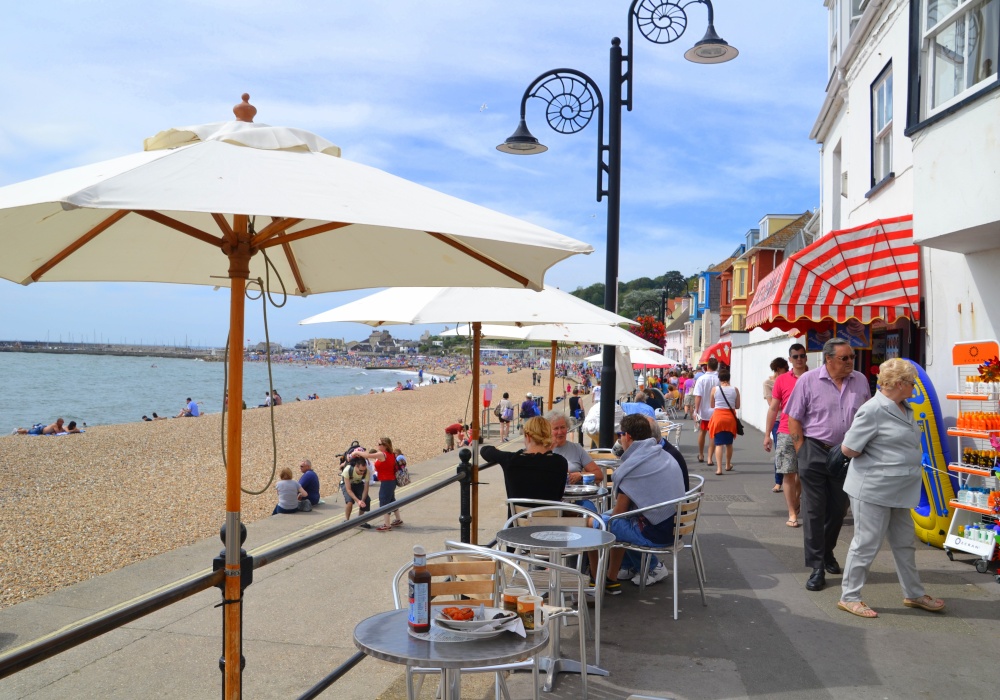
View of the beach, Lyme Regis - Image by PicturesOfEngland.com member Christine Cooney (view gallery)
Almost the first thing you notice about this pleasant seaside resort, is the spaciousness of the town. The second, and nothing can prepare you for this, is the sheer scale of Lyme Bay with its splendid views towards the rugged sandstone cliffs west of Eype Mouth. This is the dramatic Jurassic coast in all its glory.
The history of this bright seaside resort goes back to the 8th-century when monks panned salt from the sea. Lyme Regis has played its part in every period of English history to touch the town, and annually the Sealed Knot celebrates the Siege of Lyme which took place in 1644.
Visitors to the town enthuse over its elegant buildings, and enjoy its beautiful gardens - Langmoor and Lister gardens, look out over the Cobb ( which was first constructed in the 13th-century), and show a wealth of year round colour. On a clear day from Lister gardens there are fine views across the bay to Portland harbour.
A quaint feature on the beach is the re-emergence of beach huts. For many years these tiny places where considered 'naff' by almost everyone, now their benefits have been rediscovered and just about everybody wants one, including the rich and famous!
Beach huts have a mixed blessings, they shelter you from the heat of the sun, offer warmth from blustery winds, and a place to enjoy a picnic. Some still think of them as being unsightly but many enjoy their lovely splash of colour.
The ambience and atmosphere of the town is such that over the years it has drawn noted artists to its shores. One of the most famous being the American painter James Whistler who visited in the summer of 1895. Two of the portraits he painted while here, hang in the Boston Museum of Fine Art, one entitled "The Little Rose of Lyme Regis" ranks as one of his most celebrated works.
Beatrix Potter based some of her illustrations around the town, scenes for the BBC drama Persuasion were filmed here during the 1990's, and parts of Lyme Regis provided the backdrop for scenes of The French Lieutenant's Woman - a novel by John Fowls a local author written in 1969, and later turned into a film.
The beach and the sea provide endless scope for pleasure. Leisure pursuits offered include fine walks along lovely coastal paths with beach and ocean views. Paths that run through the town are the South West Coastal Path, the Ridgeway Path and the Liberty Trail. There is a Maritime Museum, and the Philpot Museum recalls stories of the people of Lyme Regis, the history of Fossils, tells of the town at the time of the Civil War, and of Pathologist, Mary Anning, there is also a shop where visitors can purchase souvenirs. An RNLI lifeboat station lies on the coast. Boats can be hired and sea-fishing trips can be arranged. In the heart of the town there is a restored mill where you can enjoy demonstrations of milling, an on site picture gallery, pottery and crafts. Here too, you will find a shop, cafe and a tranquil walled garden first established in the 17th-century. Lyme Regis offers a year long programme of events, including a Fossil Festival.
Set amid the harmony of a splendid Georgian square you will find the beautiful church dedicated to St. Michael. The church has a most attractive exterior, whilst inside visitors can explore a wealth of church treasures. In the quite churchyard there are many graves, including that of Mary Anning.
Lyme Regis offers an all year round destination, it is particularly beautiful in autumn and quite stunning during the Christmas period when the whole town and sea front are illuminated with thousands of lights
ID#32906
| Article Title | Author | Date |
| Stonehenge | David Coe | 23rd January 2024 |
| Derwent Dam: A Historic Icon in the Heart of Derbyshire | David Coe | 14th January 2024 |
| The Native Trees of England: A Botanical Tapestry | David Coe | 15th December 2023 |
| Stoke-on-Trent: The Potteries Hub | David Coe | 12th December 2023 |
| England's 'Heritage at Risk Register' 2023 | David Coe | 11th December 2023 |
| 10 of the prettiest villages in the Lake District, Cumbria | poe | 16th March 2023 |
| Where to see Daffodil Displays in the South West of England | poe | 3rd March 2023 |
| 10 Famous Landmarks in Dorset | poe | 1st March 2023 |
| List of popular Dorset market towns including market day | poe | 1st March 2023 |
| 10 Best Historic Attractions to visit in York, England | poe | 16th May 2022 |